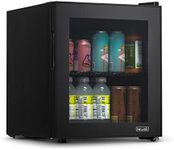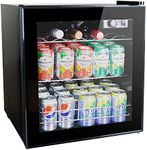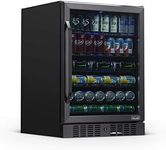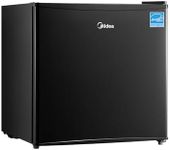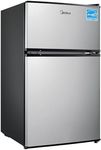Buying Guide for the Best Mini Beverage Fridge
Choosing a mini-beverage fridge is all about matching your storage needs, available space, and lifestyle. These compact fridges are perfect for keeping drinks cold in bedrooms, offices, dorms, or entertainment areas. Before you buy, think about where you’ll place it, how many drinks you want to store, and how often you’ll access it. Understanding the key features will help you find a fridge that keeps your beverages at the right temperature and fits seamlessly into your space.CapacityCapacity refers to how much the fridge can hold, usually measured in liters or by the number of cans or bottles it can store. This is important because it determines how many drinks you can keep cold at once. Small fridges might hold 6-12 cans, while larger ones can store 30 or more. If you only need a few drinks chilled at a time, a smaller capacity is fine. For parties or shared spaces, a larger fridge is better. Think about your typical usage and choose a size that matches your needs without taking up unnecessary space.
DimensionsThe physical size of the fridge is crucial, especially if you have limited space. Dimensions are usually given in height, width, and depth. Compact models fit easily on countertops or under desks, while larger ones may need their own spot on the floor. Measure your available space before shopping and compare it to the fridge’s dimensions to ensure a good fit. If you plan to move the fridge often, lighter and smaller models are easier to handle.
Temperature RangeThe temperature range tells you how cold the fridge can get. Some mini-fridges are designed just to keep drinks cool, while others can chill them to near-freezing. If you like your beverages very cold or want to store items like milk or snacks, look for a fridge with a wider or lower temperature range. Adjustable temperature controls are helpful if you want flexibility. Consider what you’ll store and how cold you want it before deciding.
Shelving and Storage LayoutThe way shelves and racks are arranged affects how you can organize your drinks. Some fridges have adjustable or removable shelves, which let you fit larger bottles or rearrange for different can sizes. Others have fixed racks designed for cans only. If you want to store a mix of cans, bottles, or even snacks, look for flexible shelving. If you only need to chill one type of drink, a simple layout may be enough.
Noise LevelMini-fridges can make noise as they run, which might be noticeable in quiet spaces like bedrooms or offices. Noise level is usually measured in decibels (dB). Lower numbers mean quieter operation. If you’re sensitive to noise or will use the fridge in a quiet area, look for models advertised as low-noise or silent. For busy or loud environments, noise may not be as important.
Energy EfficiencyEnergy efficiency tells you how much electricity the fridge uses. More efficient models use less power, which is better for the environment and can save you money on electricity bills. Look for energy ratings or features like eco-mode. If the fridge will run all the time, efficiency becomes more important. For occasional use, it may matter less.
Door Type and ReversibilityThe way the door opens can affect where you place the fridge. Some doors are reversible, meaning you can change which side they open from, which is useful for tight spaces. Others have glass doors so you can see inside without opening, while some are solid for better insulation. Think about where you’ll put the fridge and whether you need a reversible or see-through door for convenience.
Defrosting MethodSome mini-fridges require manual defrosting, meaning you’ll need to occasionally turn them off and let any ice melt. Others have automatic defrost, which is more convenient and keeps the fridge running smoothly. If you want low maintenance, look for automatic defrost. If you don’t mind occasional upkeep, manual defrost models are usually fine.

